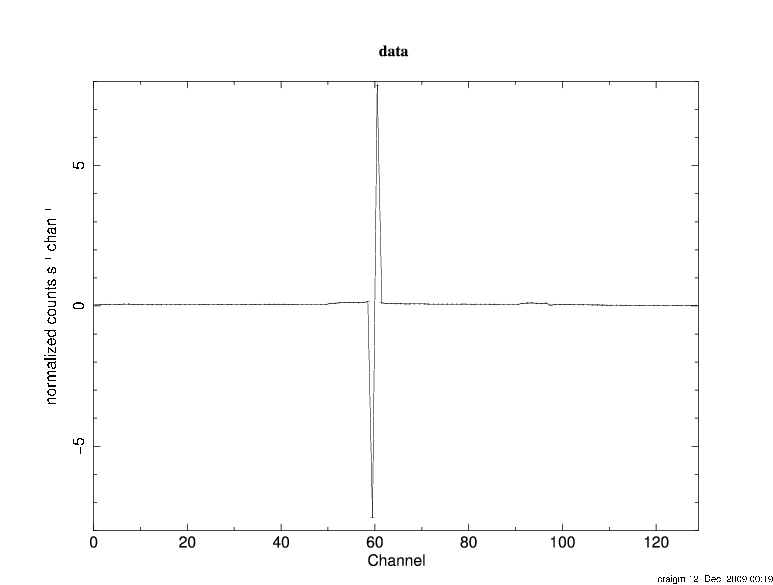|
Spike Artifacts in PCA Background Estimates Table of Contents
SummaryThis document describes spike artifacts which appear in many PCA background estimates. The spikes will produce artifacts in background-subtracted spectra analyzed with XSPEC, and may also produce spikes in light curves, depending on the binning method. These artifacts are due to a bug in pcabackest. To correct the problem, users must download pcabackest version 3.8 or later. This version was first released on 2009-12-03 with HEASOFT release 6.8. Users can download the most recent version of HEASOFT here: Unfortunately, background estimates created by older versions of pcabackest may be affected by the spike artifacts, and should be regenerated with a newer software version of pcabackest. IntroductionThe PCA is a non-imaging instrument operating in a space environment. Energetic charged particles in the spacecraft environment generate a significant count rate background, which must be accounted for in a detailed scientific investigation. The standard tool for background subtraction is pcabackest. This tool generates estimated backgrounds based on a model. The model may depend on housekeeping count rates, the position of the spacecraft in its orbit, time, and so on. By default, pcabackest generates its estimates in the same format as real count rate data, so that standard tools can be used to process the estimates. During this process, count rates are adjusted for gain shifts in the instrument, which occur over time as the detector ages. In the September 2009, the PCA team was informed of a problem with background estimates calculated by pcabackest. The symptom of the problem is large positive and negative spike artifacts in individual PCU background spectra, which may change over time. The only resolution to this problem is to use pcabackest version 3.8 or newer. DetailsThe problem manifests itself as large spikes in an estimated PCU spectrum.
For an example, see Figure 1. In this case, the spike artifact occurred in PCU2, layer 2. There are large count rates which are not representative of the actual estimated background. The root cause of this problem was identified to be an error in an interpolation routine within pcabackest. This interpolation routine is used to adjust the counts according to the known gain shifts in each detector and layer. The error introduces the possibility of a "divide-by-zero" condition, or division by "nearly zero," which results in large errors in the output. The problem is magnified when an original bin edge and an interpolated bin edge intersect. There are several symptoms that are typical to this problem:
This problem can occur in any PCU or layer. It largely depends on which components of the background model are near zero, and all PCUs have background components which fit this criterium. The problem is sporadic. As bin edges gradually shift over time, the symptoms will also shift. It is not clear how often the problem will be immediately visible, but there will likely be other cases where the problem is more subtle, but may still have a significant impact to science. The problem is primarily constrained to bins above 20 keV. This reason for this has to do with how the interpolation routine works and how the Standard2 data mode is binned. The erroneous interpolation only applies to Standard2 bins which are formed from more than one PCA channel (for example if two pulse height channels are grouped into one bin). This type of binning only occurs above 20 keV. For most users which focus on analysis below 20 keV, there should not be a problem. The artifacts, when they appear, should show two adjacent bins with large positive and negative excursions. The interpolation algorithm attempts to "conserve flux." If it attempts to move excessive counts to a neighboring bin, then the original bin will have a resulting deficit. Overall, the sum of the two adjacent bins should come out to a reasonable background level. ImpactsThis artifact has several obvious impacts. First, spectral analysis in XSPEC will show obvious defects at the energies where these artifacts are present. Generally, XSPEC may attempt to mask bins with negative counts. In that case, only the large positive excursion might be seen. In other cases, both large positive and negative residuals may be apparent. Also, if the user groups several bins together, then the effect of the artifacts may be hidden, since the sum of the two bins will typically be a reasonable value. The artifacts should only be apparent above ~20 keV. Below that energy, there should not be artifacts. Light curve analysis may also be affected. Generally, if one constructs a light curve with requested energy bins that average over the adjacent bins, then there may be no discernable artifact. However, if the requested light curve energy bins happen to divide the pair of Standard2 bins, then large count rate anomalies might be visible. In principle there is no limit to the magnitude of the spikes. Examples have been found with count rates of thousands of counts per second. RemediesThere are two basic remedies. The PCA team recommends that users download pcabackest version 3.8 or newer. This version contains a fix which avoids the erroneous division-by-zero problem. There should be no more spikes present after installing pcabackestion version 3.8 or later. Users will need to take care to re-process old data in order to re-calculate the background estimates. The second remedy is to use the "VLE" model. This model is designated for bright sources, but in fact is quite usable for intermediate brightness sources as well. Users who are interested in investigating this option can consult this report, which discusses the systematic errors inherent in both models. ConclusionThe PCA team recommends to upgrade to pcabackest version 3.8 or newer. AcknowledgmentsThe PCA team would like to thank John Tomsick for bringing this problem to our attention. Changes
If you have a question about RXTE, please send email to one of our help desks.
|


